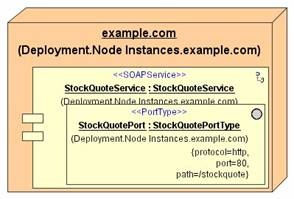|
MIME Binding
Not supported by the WSDL Importer yet. You will get an error message that ports having this binding are ignored. However, accessing such services can easily be done using the URL Adapter. Importing a WSDL file that contains services having both SOAP and MIME bindings will result in the import of the ports associated with the SOAP binding neglecting ports having different bindings.
List of all Binding Elements
 soap:binding
soap:binding
The Importer supports two types of
soap:bindings: document and RPC
style. Examples of these two bindings are found in the following table:
Figure: Valid soap:binding examples and their UML counterparts
|
| ||
|
|
The encoding of the operation is given by the stereotype <<DocumentEncoding>> if the WSDL binding style is document. If we have an RPC style operation no stereotype is given. The Importer will report an error in all other cases.
The SOAP action value is put into the soapAction tagged value.
 soap:operation
soap:operation
The
soap:operation element contains the soapAction attribute (see figure Valid soap:binding examples and their UML counterparts ). This attribute gets imported as soapAction tagged value.
 soap:body
soap:body
The
soap:body element specifies how the message parts appear inside the SOAP Body element.
The soap:body binding element provides information on how to assemble the different message parts inside the Body element of the SOAP message. The soap:body element is used in both RPC-oriented and document-oriented messages, but the style of the enclosing operation has important effects how the WSDL Importer handles the soap:body element:
- If the operation style is RPC each part of the associated message is a parameter or a return. These parts must have a type attribute referring to a SOAP encoded type schema. Thus, the Importer will report an error if the
soap:bodyelement does not contain the following attributes:use="encoded" encodingStyle="http://schemas.xmlsoap.org/soap/encoding/". - If the operation style is Document each part of the associated message is an element of a XML Schema. These parts must have an element attribute refering to a literal XML Schema. Thus, the Importer will report an error if the soap:body element does not contain the following attributes:
use="literal".
 soap:fault
soap:fault
The
soap:fault element specifies the contents of the SOAP Fault Details element. This element is not supported by the Importer. If a SOAP fault occurs, the Bridge generates internally an exception containing the fault code. This exception can then be handled by the modeler. The contents of the SOAP Fault Details element is put into the message part of the Bridge exception as plain string.
 soap:header and soap:headerfault
soap:header and soap:headerfault
Not supported by the WSDL Importer yet.
 soap:address
soap:address
The soap:address element defines the physical location of a port contained in a service. In UML, this information is expressed in deployment diagrams. The following table compares a WSDL fragment to the corresponding UML diagram:
Figure: soap:address and its Meaning for UML Deployment Diagrams
|
|
The above table shows that the soap:address location value is split into its parts. The protocol part becomes the protocol tagged value at port instance StockQuotePort. The network port becomes the port tagged value and the path information is put into yet another tagged value, namely path. The physical location encoded in the location attribute is mapped to an UML node instance having the name of a physical address, in this example: example.com.


